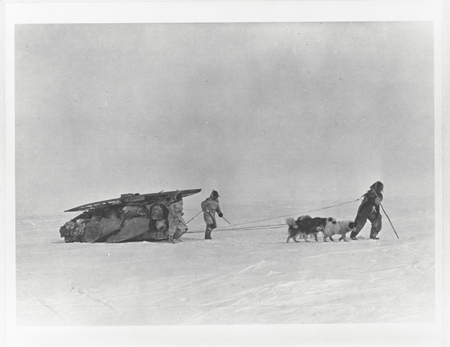In this Post
From the
Editor
Historic Nansen Sledge Gifted
The Enduring Love of Those Huskies
Flush at Stonington in 1964
Film Review: Atautsikut – Leaving None Behind
The Qikiqtani Qimuksiqtiit Project
Web News: Greenland Travel Guide; Inuit Literature Website; Another failed social experiment
Defining the Inuit Dog: web pages refreshed
Historic Nansen Sledge Gifted
The Enduring Love of Those Huskies
Flush at Stonington in 1964
Film Review: Atautsikut – Leaving None Behind
The Qikiqtani Qimuksiqtiit Project
Web News: Greenland Travel Guide; Inuit Literature Website; Another failed social experiment
Defining the Inuit Dog: web pages refreshed
Navigating This Site
Index of articles by subject
Index of Journal editions by
volume number
Index of PostScript editions by publication number
Search The Fan Hitch
Articles to download and print
Ordering Ken MacRury's Thesis
Our comprehensive list of resources
Defining the Inuit Dog
Talk to The Fan Hitch
Shop & Support Center
The Fan Hitch home page
Index of articles by subject
Index of Journal editions by
volume number
Index of PostScript editions by publication number
Search The Fan Hitch
Articles to download and print
Ordering Ken MacRury's Thesis
Our comprehensive list of resources
Defining the Inuit Dog
Talk to The Fan Hitch
Shop & Support Center
The Fan Hitch home page
Editor's/Publisher's
Statement
Editor: Sue Hamilton
Webmaster: Mark Hamilton
The Fan Hitch Website and
Publications of the Inuit Sled Dog– the
quarterly Journal (retired
in 2018) and PostScript – are dedicated to the aboriginal
landrace traditional Inuit Sled Dog as well as
related Inuit culture and traditions.
PostScript is
published intermittently as
material becomes available. Online access is
free at: https://thefanhitch.org.
PostScript welcomes your
letters, stories, comments and suggestions.
The editorial staff reserves the right to
edit submissions used for publication.
Contents of The Fan Hitch Website and its publications are protected by international copyright laws. No photo, drawing or text may be reproduced in any form without written consent. Webmasters please note: written consent is necessary before linking this site to yours! Please forward requests to Sue Hamilton, 55 Town Line Rd., Harwinton, Connecticut 06791, USA or mail@thefanhitch.org
Contents of The Fan Hitch Website and its publications are protected by international copyright laws. No photo, drawing or text may be reproduced in any form without written consent. Webmasters please note: written consent is necessary before linking this site to yours! Please forward requests to Sue Hamilton, 55 Town Line Rd., Harwinton, Connecticut 06791, USA or mail@thefanhitch.org

Copper Eskimo family travelling with dog sled, Coronation Gulf, Northwest Territories (Nunavut);
photographed during the 1913-1918 Canadian Arctic Expedition lead by Vilhjalmur Stefansson.
Photo: R.M.Anderson;archived as #20288 in the Canadian Museum of History
Defining the Inuit
Dog web pages refreshed
Originally created in August 2011 and revised in January 2014, The Fan Hitch website’s “Defining the Inuit Dog” has been overdue for a face lift. Mea culpa for taking way too long to get this done.
Based on the explosion of published scientific research over the past couple of decades on the origins of dog domestication in general and a host of those papers focused on the aboriginal landrace Inuit Sled Dog in particular, clearly section III. A. Ancient history needed an update. In this regard The Fan Hitch once again owes a debt of gratitude to evolutionary biologist Sarah Brown, PhD for answering the call to build on the foundation work Ken MacRury did in the history section of his 1991 master’s thesis. The science of genetics and DNA analyses has since progressed in leaps and bounds.
Another major update to Defining the Inuit Dog has been the removal of categorizing this landrace as a primitive aboriginal dog. The identification of the Inuit Dog, indeed many aboriginal landraces, as primitive had been controversial and deemed a misinterpretation. In section I. A. The Inuit Dog’s Place in the Natural World, the Primitive and Aboriginal Dog Society’s definition of a primitive dog is explained, limiting that moniker to the Dingo and the New Guinea Singing Dog. It makes sense.
The 2020 version of Defining the Inuit Dog’s new look also incorporates many additional photographs, including contributions of Greenland Inuit Dogs from Norway’s Gisle Uren, behavioural biologist Dr. Giulia Morosetti who spent much time in East Greenland collecting data for her master’s degree “I cani da slitta indigeni dell’Arctico: Simbolo dell’identità dei loro popoli e patrimonia dell’umanità”/“The indigenous sled dogs of the Arctic: Symbols of the identity of their populations and patrimonies of humanity”, and two explicit images of wild and domesticated foxes from the Belyaev research project courtesy of the Institute of Cytology and Genetics of the Siberian Branch of the Russian Academy of Science thanks to the assistance of Dr. Ilya Volodin at the Lomonosov Moscow State University. Спасибо, Илья!
Also, the three appendices have been augmented to include more scientific papers, non-fiction books and movie/documentary titles. So much has developed over the past sixteen years! Again, shame on me for not keeping up.
Defining the Inuit Dog is just an enhanced summary of this aboriginal landrace. But it’s a good starting point for those unfamiliar with this dog, others seeking resources for their own projects and perhaps even for folks looking to open their minds to the differences between aboriginal landraces and cultured breed dogs. The many references to other publications, such as Ken MacRury’s master’s thesis The Inuit Dog: Its Provenance, Environment and History, Kim Han’s book The Canadian Inuit Dog: Icon of Canada’s North and, for example, the movie Okpik’s Dream, offer in-depth descriptions of various aspects pertaining to this dog including its social significance. You are encouraged to explore beyond Defining the Inuit Dog itself to learn more, including from the other “Defining the Inuit Dog” which was written by Mark Brazeau of Kangiqsualujjuaq, Nunavik back in the December of 2006 issue of The Fan Hitch Journal where he interviewed Tivi Etok and Johnny-George Annanack, Inuit Elders whose knowledge of this aboriginal landrace came first hand from a time when their survival depended on their dogs.